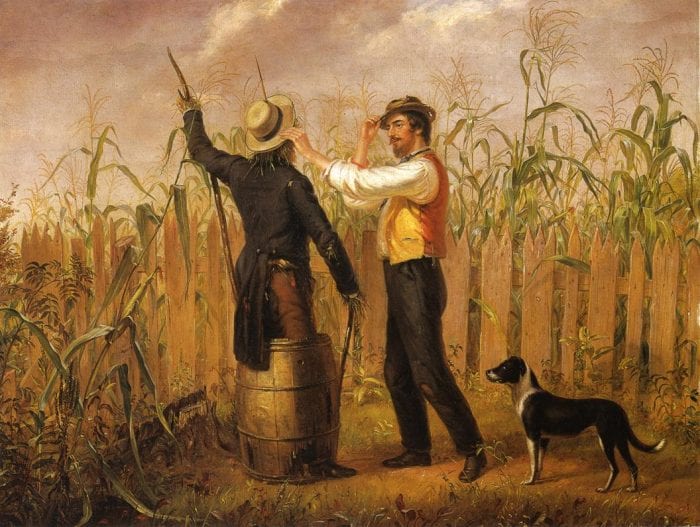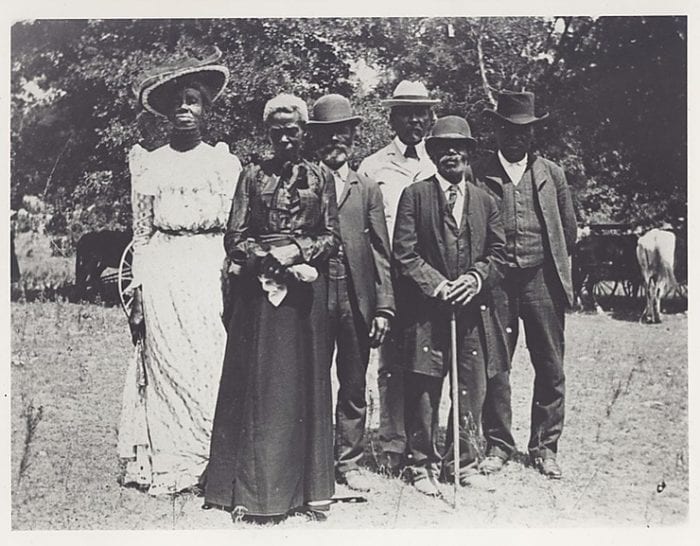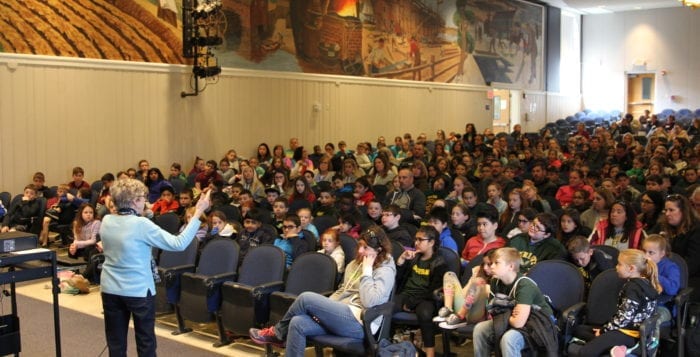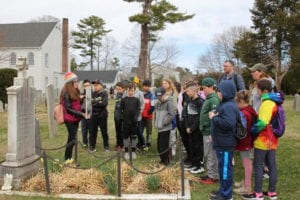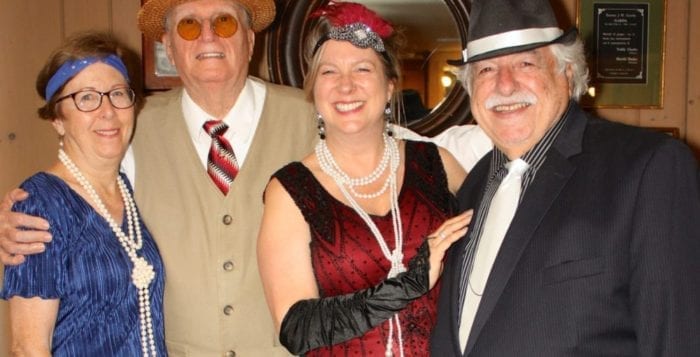By Tara Ebrahimian
William Sidney Mount was an artist whose Long Island heritage was integral to his identity and his art. Most famous for his portrayals of local and natural life, Mount’s initial interest in historical paintings and his commissions for death portraiture led him to create the work that would become his legacy. What Mount witnessed and experienced determined how he rendered the realm he could control: his art.
He was born in Setauket on November 26, 1807. His parents, Julia Ann Hawkins and Thomas Shephard Mount, had a farm and also ran a store and tavern on the edge of the village green. Interested in artistic endeavors from a young age, with his family’s support, he set out to pursue that goal.
Following his father’s death in 1814, his mother returned to his grandfather’s farm in Stony Brook and Mount lived for a time with his maternal aunt and uncle, Letty and Micah Hawkins, in New York City. Micah was a playwright, composer, and musician, who encouraged Mount’s interest in music. In 1815, Mount returned to Long Island, living in his grandfather’s home until returning to Manhattan where he apprenticed to his brother Henry as a sign maker. It was during this period that Mount really began to develop his interest in painting.
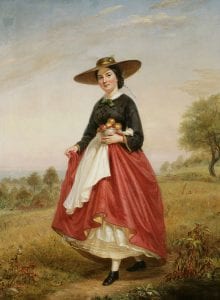
With Henry’s encouragement, Mount attended the American Academy of the Fine Arts exhibition at City Hall Park in 1825. This event introduced Mount to a genre of art he had not yet enjoyed: history painting. Rather than pursue a formal art education or seek tutelage from a master, Mount continued to work for his brother while teaching himself. Henry was now business partners with a painter named William Inslee, who owned a collection of prints by British artist William Hogarth, who specialized in history painting. Moved by his art as well as that of another British artist, Benjamin West, Mount copied Hogarth’s prints in order to practice his craft.
History painting is characterized by its content instead of its artistic method. This form generally depicts an instance in a narrative story rather than a specific, fixed subject such as a portrait. Until the 19th century, history painting was considered the most prestigious type of Western painting. Then, as artists pushed back against the rigid parameters of academic art standards, it became a medium mainly regarded in that milieu. This genre encompassed works that portrayed religious scenes, and Mount’s most popular history painting is of this nature.
Upon the recommendation of family friend Martin E. Thompson, Mount enrolled in the National Academy of Design, which Thompson had cofounded. At the institution Mount was able to explore his appreciation for the Grand Manner, an idealized aestheticism that drew from classicism and the art of the high Renaissance. Initially it specifically referred to history painting, but came to include portraiture. The term Grand Manner was also used by British artists and critics to describe art that incorporated visual metaphors to represent noble characteristics.
In this manner, Mount created historical paintings that were very well received. He selected scenes from classical texts that focused on topics like near-death experiences, death, and resurrection. Mount’s first notable oil painting, Christ Raising the Daughter of Jairus (1828) caused a stir when it was exhibited at the National Academy of Design; the council was stunned that a young artist with little formal instruction could produce such a work. Mount, who was one of the school’s first students, was elected an associate member in 1831.
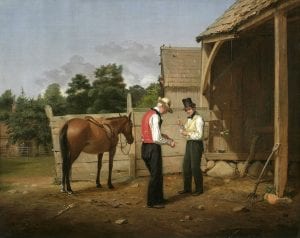
He returned to Setauket the next year, but continued to send work to be exhibited in New York City. Mount’s history paintings were admired and respected, but they were not, apparently, particularly profitable. Perhaps impacted by the shifting opinions about historical paintings, Mount suffered a setback all too familiar to artists: his work did not sell well enough for him to make a living. So, he shifted his focus to portraiture. His first portrait subjects were easily persuaded: he painted himself and close relatives.
Portraits provided a somewhat steadier income. Among his early patrons were the Weeks, Mils, Wells, and Strong families. Mount continued to improve his technique and was happy to be back on Long Island. “I found that portraits improved my colouring, and for pleasurable practice in that department I retired into the country to paint the mugs of Long Island Yeomanry.” Mount was less enamored with the other aspect of his business: death portraiture.
Mourning portraits were paintings of the recently deceased. Frequently the subjects were shown as though they were alive, and symbolic details, like bodies of water and flowers, were used to indicate that they were not. Arguably a bit morbid, their existence was emotional: they were usually commissioned by the departed’s loved ones. It could be among the only renderings/images that existed of the recently dead.
Mount worked on commission and he did not enjoy the work, which was fraught and could be gruesome. He could be summoned to someone’s wake or deathbed to make sketches or take notes for the upcoming portrait. Once he was called to the scene of an accident to paint the likeness of a man who had been run over by a wagon. The final product did not reflect the cause and nature of the subject’s death.
The art Mount created enveloped aspects of genres he had explored earlier in his career. These experiences helped him establish the style for which he would become best known. He combined the narrative elements of the history paintings with the human interest element of the death portraiture. Without this background, he may not have been inspired to create the art that became his job and his joy.
Genre paintings, art that illustrates scenes of everyday life, became the most renowned selections of his oeuvre. Unlike his previous work, this type of art is distinguished from history paintings and portraits in that the subjects have no distinctive identities. His first foray into this type of painting, The Rustic Dance, was immediately successful and encouraged him to further explore the medium. As Mount noted in his journal, “Ideas can be found in everything if the poet, sculptor and painter can pick them out.” He captured snippets of everyday life and frequently imbued them with subtle or more overt themes of social commentary.
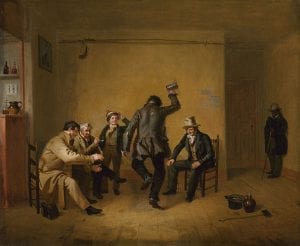
Motivated by the natural environment and his neighbors, Mount addressed moral issues, including economic standing and disparities as well as the implied status of Black people in the area. For example, in Bar-Room Scene (1835), Mount portrays patrons in a tavern. In the foreground a presumably inebriated man in tattered clothing is encouraged to dance by three seated men who are clearly of a higher economic class. A boy, who is standing, gazes upon him in apparent wonderment.
In the back corner, there is a young Black man standing. He is also entertained by the dancer’s antics, but he is alone, separate from the group of other men. As a free Black man, he is allowed to visit the tavern, but he remains apart from the other visitors. Through this isolation, Mount indicates that the man is not fully able to participate in the community. The topics represented in this painting were recurring in his art.
Mount’s return to the Three Villages marked a shift in the nature of his work. His exploration of slavery, racial dynamics, and rustic vignettes offer indelible insight into 19th century life on Long Island. His creative expression was a culmination of previous artistic enterprises, driven by both his own passion and financial necessity. Mount continued to paint, integrating other interests, such as music, into his art. He never married or had children and died of pneumonia on November 18,1868, at his brother Robert’s house in Setauket.
Author Tara Ebrahimian is the Education Coordinator at the Three Village Historical Society in Setauket. This article originally appeared on the historical society’s website and is reprinted with permission.

